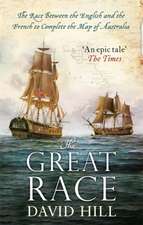Science, Museums and Collecting the Indigenous Dead in Colonial Australia: Palgrave Studies in Pacific History
Autor Paul Turnbullen Limba Engleză Hardback – 11 ian 2018
| Toate formatele și edițiile | Preț | Express |
|---|---|---|
| Paperback (1) | 216.49 lei 38-44 zile | |
| Springer International Publishing – 4 iun 2019 | 216.49 lei 38-44 zile | |
| Hardback (1) | 759.91 lei 38-44 zile | |
| Springer International Publishing – 11 ian 2018 | 759.91 lei 38-44 zile |
Preț: 759.91 lei
Preț vechi: 835.07 lei
-9% Nou
Puncte Express: 1140
Preț estimativ în valută:
145.40€ • 152.25$ • 120.61£
145.40€ • 152.25$ • 120.61£
Carte tipărită la comandă
Livrare economică 05-11 aprilie
Preluare comenzi: 021 569.72.76
Specificații
ISBN-13: 9783319518732
ISBN-10: 3319518739
Pagini: 284
Ilustrații: XIII, 428 p. 6 illus.
Dimensiuni: 148 x 210 mm
Greutate: 0.68 kg
Ediția:1st ed. 2017
Editura: Springer International Publishing
Colecția Palgrave Macmillan
Seria Palgrave Studies in Pacific History
Locul publicării:Cham, Switzerland
ISBN-10: 3319518739
Pagini: 284
Ilustrații: XIII, 428 p. 6 illus.
Dimensiuni: 148 x 210 mm
Greutate: 0.68 kg
Ediția:1st ed. 2017
Editura: Springer International Publishing
Colecția Palgrave Macmillan
Seria Palgrave Studies in Pacific History
Locul publicării:Cham, Switzerland
Cuprins
1: Introduction: ‘To What Strange Uses’.- 2: European Anatomists and Indigenous Australian Bodily Remains, c. 1788–1820.- 3: Skeletal Collecting before Darwin.- 4: Indigenous Remains in British Anatomical and Ethnographic Discourse, 1810–1850.- 5: The Indigenous Body and British Polygenists, 1820–1880.- 6: ‘Rare Work for the Professors’: Phrenologists and the Australian Skull, c. 1815–1860.- 7: Colonial Museums and the Indigenous Dead, c. 1830–1874.- 8: ‘Judicious Collectors’, 1870–1914.- 9: ‘Tales of Blood and Mummies’: The Queensland Museum, 1870–1914 .- 10: Anthropological Collecting and Colonial Violence in Late Nineteenth Century Australia.- 11. Indigenous Australians’ Defence of the Ancestral Dead.- 12: Repatriation and Its Critics.- 13: Conclusion.
Recenzii
“Science, Museums and Collecting the Indigenous Dead in Colonial Australia offers a valuable contribution to the historiography of racial science and collecting in Australia. … The book is worthwhile reading not only for historians of science and medicine, scientists and museum professionals, and those work in the field of repatriation, but for anyone interested in the material and affective legacies concerning the colonial oppression of Australia’s Indigenous peoples.” (Eugenia Pacitti, Health and History, Vol. 22 (2), 2020)
“Turnbull’s work is a rigorous and lively testimony to the significance of the history of science discipline for contemporary issues of indigeneity and postcoloniality. … Historians of science and collections, museum professionals, scientists, and activists concerned with repatriation will therefore find this book useful and valuable reading.” (Ricardo Roque, Isis, Vol. 111 (1), 2020)
“The strength of Turnbull’s book is the systematic way he works through the different processes of collecting. … Turnbull’s ground-breaking work reads as two separate books: one on the removal of the remains and the other on the return of remains. However, in both areas, Turnbull has made a significant contribution to both the study and practice.” (Gareth Knapman, History Australia, Vol. 16 (3), 2019)
Notă biografică
Paul Turnbull is Professor of History and Digital Humanities at the University of Tasmania, Australia, and Honorary Professor in History at the University of Queensland, Australia. He is the author of numerous essays on Western biomedical interest in the indigenous peoples of Oceania and is co-editor of The Dead and Their Possessions: Repatriation in Principle, Policy and Practice (2004) and The Long Journey Home: the Meanings and Values of Repatriation (2010).
Textul de pe ultima copertă
This book draws on over twenty years’ investigation of scientific archives in Europe, Australia, and other former British settler colonies. It explains how and why skulls and other bodily structures of Indigenous Australians became the focus of scientific curiosity about the nature and origins of human diversity from the early years of colonisation in the late eighteenth century to Australia achieving nationhood at the turn of the twentieth century. The last thirty years have seen the world's indigenous peoples seek the return of their ancestors' bodily remains from museums and medical schools throughout the western world. Turnbull reveals how the remains of the continent's first inhabitants were collected during the long nineteenth century by the plundering of their traditional burial places. He also explores the question of whether museums also acquired the bones of men and women who were killed in Australian frontier regions by military, armed police and settlers.
Caracteristici
The first in-depth history of scientific curiosity about the Australian Indigenous body Expands the understanding of the relations between exploration and collecting in spheres of European colonial ambition and metropolitan-based medico-scientific activities Reveals the ethical tensions and disruptive dangers of the scientific interest in Aboriginal remains and their treatment Includes supplementary material: sn.pub/extras

















